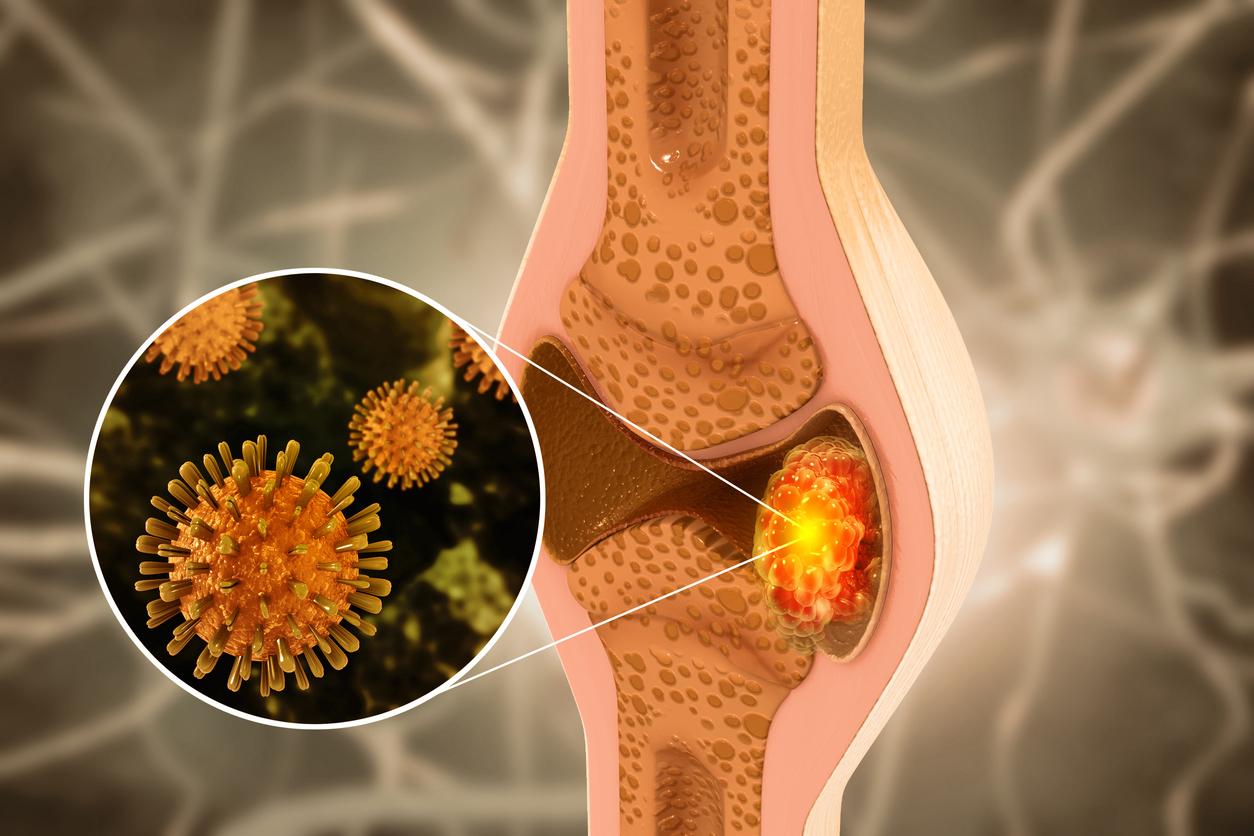- Multiple myeloma: what are the symptoms?
- Do we know the causes of multiple myeloma?
- How is the diagnosis made?
- Multiple myeloma: what treatment exists?
- Is the treatment toxic?
- Can multiple myeloma be treated well?
Multiple myeloma is a plasma cell disease, the cells that make antibodies and help fight infection. “In the case of multiple myeloma, these cells will produce an antibody in an abnormal quantity and always the samesays Dr. Vincent Ribrag, head of the hematology department at the Gustave Roussy Institute. These malignant cells develop and live in the bones and cause, among other things, bone lesions or even hypercalcemia..”
These plasma cells will grow in abnormal numbers, will destroy the bones and will at the same time smother white and red blood cells which are healthy cells. They will also create a protein (an antibody) which can be toxic: it will diffuse into healthy tissues, in particular the kidneys and nerves, which can then create kidney failure and neuropathy.
Finally, the cells creating antibodies being sick, they produce less normal antibodies, which can be responsible for infections, in particular pulmonary infections: the immune system can no longer fight properly.
Multiple myeloma: what are the symptoms?
When the disease is present, the telltale symptoms of multiple myeloma may be the following:
- Bone pain or weakness;
- Anemia caused by a reduction in the number of red blood cells ;
- Fatigue ;
- Frequent infections;
- Kidney failure, which can be caused by hypercalcemia.
“But in some cases, multiple myeloma remains asymptomatic and does not make patients sick, there is no bone damage, no significant monoclonal peak (the toxic protein), no hypercalcemia and renal failure “says Dr. Ribrag.
Do we know the causes of multiple myeloma?
Today, the causes of multiple myeloma are still unknown. “The incidence is known to increase with age, it usually happens in people over 50 and is relatively rare before that, although it can happen.”explains the hematologist.
“The incidence is also higher in African-American and West Indian populations, although we do not know why.he continues.
How is the diagnosis made?
Today, the circumstances of discovery of myeloma are quite fortuitous, most of the time thanks to blood or urine tests prescribed by his attending physician. But beware, a blood test and abnormal results are not automatically a sign of multiple myeloma. “A monoclonal immunoglobulin is not myeloma: it can be a sign of other diseases such as lymphoma or scars from the immune system that do not make you sick.”
To confirm or not the presence of the disease and receive a positive diagnosis (or not), it is necessary to perform a myelogram, or a puncture directly in the bone. “The myelogram is performed under local anesthesia at the level of the sternum, it is not dangerous and rather fastdetails the specialist. It’s quite invasive, but we can’t do otherwise for the moment.”
Multiple myeloma: what treatment exists?
Depending on the type of myeloma or the age, the treatment strategies will be different. “In the case of myelomas that do not make you sick, it is necessary to monitor them, every three months at first, in order to see how they evolve”admits the doctor.
When multiple myeloma causes symptoms, the strategy will be adapted according to the patient’s age. In a young patient, the first step will be to reduce the tumor mass by combining several drugs which will be the cause of cell death, in particular based on monoclonal antibodies, which target a protein on the cell surface, and proteasome inhibitors and lenalidomide-type immunomodulators that will help reduce the disease as much as possible from the start. “It is imperative that these patients do not have children during treatment.”warns Dr. Ribrag.
“Once the disease has been controlled, in young patients, we will perform apheresis, that is to say that we will collect healthy cells – white and red blood cells – we freeze them and keep them aside. During this time we administer a toxic drug for the remaining abnormal cells, then once it has taken effect, we reinject the healthy cells. This is called an autograft.details the hematologist.
In the elderly, this intervention will be too heavy, and only the preliminary treatment will be administered.
Is the treatment toxic?
“These treatments have an effect on immunity, and do not restore total immunity: the risks of infection in these patients are high. In the case of Covid-19, even vaccines may be less effective in preventing infection.”regrets the doctor.
Medication can also cause neuropathy, some patients may no longer feel their hands or feet. “Watch out for severe neuropathieswarns Dr. Ribrag. When you feel ants in your hands or feet, it is important to warn the doctors, in order to readjust the treatment..”
Can multiple myeloma be treated well?
“There is no cure for the disease, but it has become chronicsays the specialist. A patient can live a long time with multiple myeloma and in good conditions”. The disease may be associated with a extended life expectancy, now an additional 10 to 15 years.
“Multiple myeloma remains a serious disease, but treatments are changing fast, providing an extended quality of life.”he finishes.
Our speaker:
- Dr. Vincent Ribrag, head of the hematology department at the Gustave Roussy Institute in Villejuif
Read also:
- Fatigue: what your blood test reveals
- Cancer: 4 questions we ask ourselves about lymphoma
- Anemia: it is not necessarily a lack of iron


















